National Strategies
1. Background
Establishing a strategic direction for nano-field research and development to preemptively respond to global economic, social, and technological changes and to utilize nanotechnology to solve technological challenges in various areas.
The Fourth National Nanotechnology Roadmap (’23 - ’32) strengthen the linkage between the strategic nanotechnology roadmap and the preliminary technology map to clearly present the mission and role of nanotechnology R&D.
2. How the Fourth National Nanotechnology Roadmap Be Established
Defining the Nine Big Questions; presenting the role of nanotechnology in problem-solving planning nano-infrastructure innovation
Choosing the Big Questions and developing the strategic nanotechnology roadmap and proactive in-depth roadmap
3. Tentative Fourth National Nanotechnology Roadmap ('23–'32)
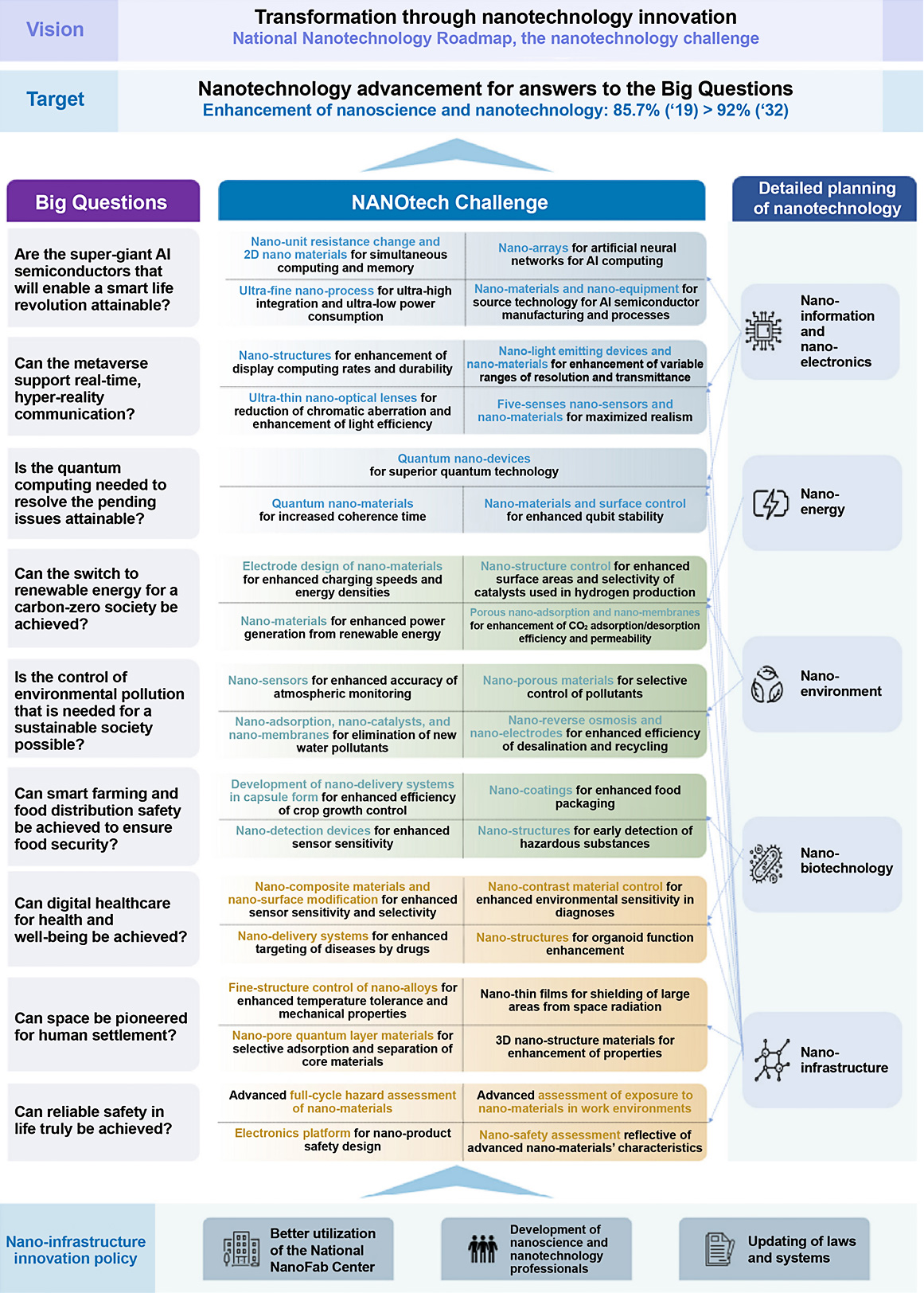
- Utilizing the National NanoFab infrastructure for innovation in key areas of nanotechnology
Upgrading advanced nanofab facilities and equipment to strengthen research and industrialization support capabilities by field
Expanding linkage and cooperation between infrastructures
Use of National NanoFab Center Infrastructure in Different Areas Classification Details Information and electronics Establishment of quantum nano-electronics manufacturing infrastructure running on universal technology; development of standard process technology Energy Establishment of a system for technical support for next-generation secondary cells (solid-state lithium batteries) leading to process setup and commercialization validation Environment Improved test beds for carbon-zero processes in the areas of semiconductors and displays Biotechnology Technical support for R&BD for biotechnology convergence using nano-infrastructure Infrastructure Integrated Nano-infrastructure Information System (Virtual Fab) - Fostering the nanothechnology workforce
Using advanced nano-infrastructure to develop convergence nanotechnology professionals capable of contributing to R&D and commercialization in specialized high schools, junior colleges, universities, and workplaces
- Revision of the Nanotechnology Development Promotion Act to promote technology advancement
Revising the Nanotechnology Development Promotion Act to reflect the changes in the internal and external environment that have occurred since its enactment in 2002; updating measurement standards, technological impact assessment, and all other relevant particulars
4. Expected Effects and Execution
Implementation of the Fourth National Nanotechnology Roadmap to answer the Nine Big Questions and advance the nanotechnology infrastructure in order to complete national tasks and innovate nanoscience and nanotechnology for the future
Incorporation of nanotechnology-related ideas identified as enhancing the practicality and strategy of the Fourth National Nanotechnology Roadmap into the planning of national nanotechnology R&D budgets and projects
1. Background
Creating breakthroughs with technological innovations in uncertain future of the Next Normal Era
- Emergence of the “Next Normal” era due to global value chain reorganization as a result of the pandemic and the U.S.-China(G2) technology and trade war.
*Five major trends in post-COVID-19 era △ Acceleration of deglobalization △ Resilience, rather than efficiency △ Promotion of digital transformation △ Changes in consumption behavior according to income level and health interests △ Increased importance of trust
Type New Normal Next Normal*(Mckinsey, 2020) Cause 2008 Global Financial Crisis Pandemic (COVID-19) Characteristics Limited to financial and economic sectors Entire economy/society Impact Mostly manufacturing industry Manufacturing + digital/low-carbon industries - Science and technology, along with products based on them, will create a predictable era in the newly emerging future from a crisis.
Nanotechnology is a general-purpose technology and a cutting-edge technology with a significant ripple effect
- Nanotechnology interacts with various technology sectors and is applicable in major manufacturing sectors, including AI, biotech, and energy (OECD STI Outlook, 2018).
- The cutting-edge nature gives disruptive power that is unpredictable to gauge when successful, and the general-purpose nature spreads the ripple effect of the technology by converging with various other technologies and industries.
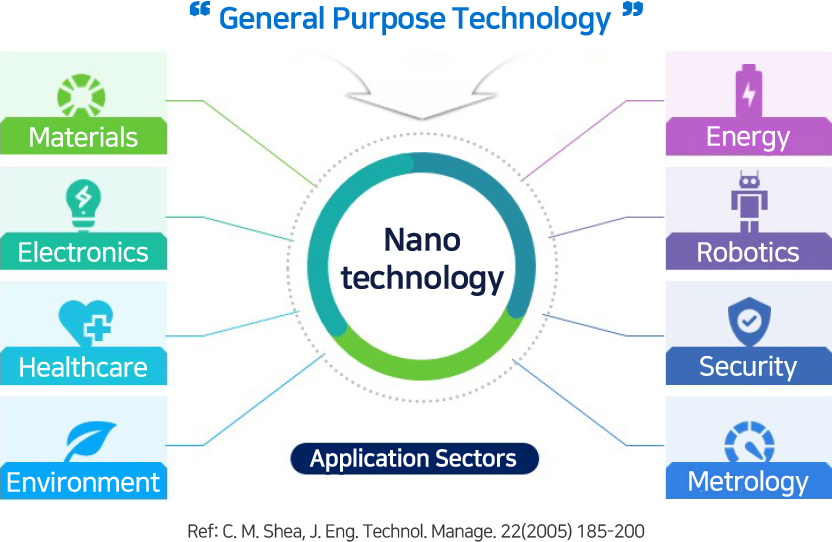
Definition of nanotechnology
- Technology that imparts new or improved performance to products through manipulation of equipment or manufacture of materials with dimensions in nanometers (1~100nm).
Applicable sectors for nanotechnology
| Type | Six major sectors | Technology characteristics |
|---|---|---|
| Applied technology | Nano device (electronics) | Realization of high-level integration and low power consumption by reducing circuit width in nano units |
| Nano energy/ environment | Increased energy storage and efficiency by applying nano particles | |
| Nano-bio | Development of biocompatible tissues and rapid/accurate diagnostics with nano-sized structures | |
| Fundamental technology | Nanomaterials | Revelation of new properties and functions by structural control at the atomic level |
| Nano process/ metrology equipment | Mass production of nanomaterials, specific functions, and nano-scale analysis | |
| Nano safety | Establishment of a system and scientific evidence for using safe nanomaterials and product |
Moreover, all-round integrated technology for material/component/equipment and semiconductor industries that are ongoing national interests
- Achievements in the field of nanotechnology are mostly realized in forms of (nano)materials and components,* semiconductor technology is an example sector in which nano material process technology has been applied.
* The government-funded Nano-Convergence 2020 Project consists of 70% materials, 20% equipments, and 10% components. - Nanotechnology can promote development of new industries, such as system semiconductors, and respond to changes in global value chain of six major industrial sectors.*
* Semiconductor, display, automotive, electricity/electronics, machinery/metal, and basic chemicals
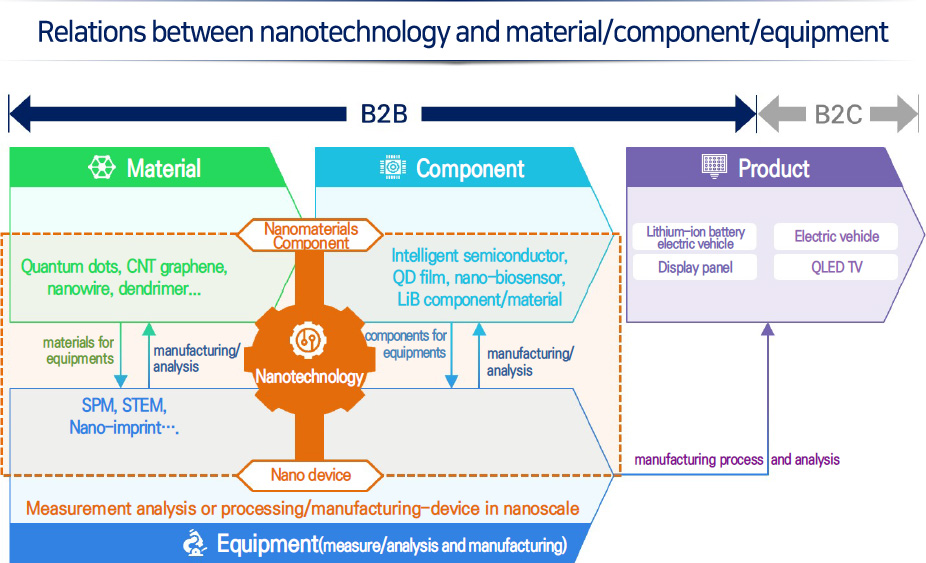
Note 1 Advances in nanotechnology
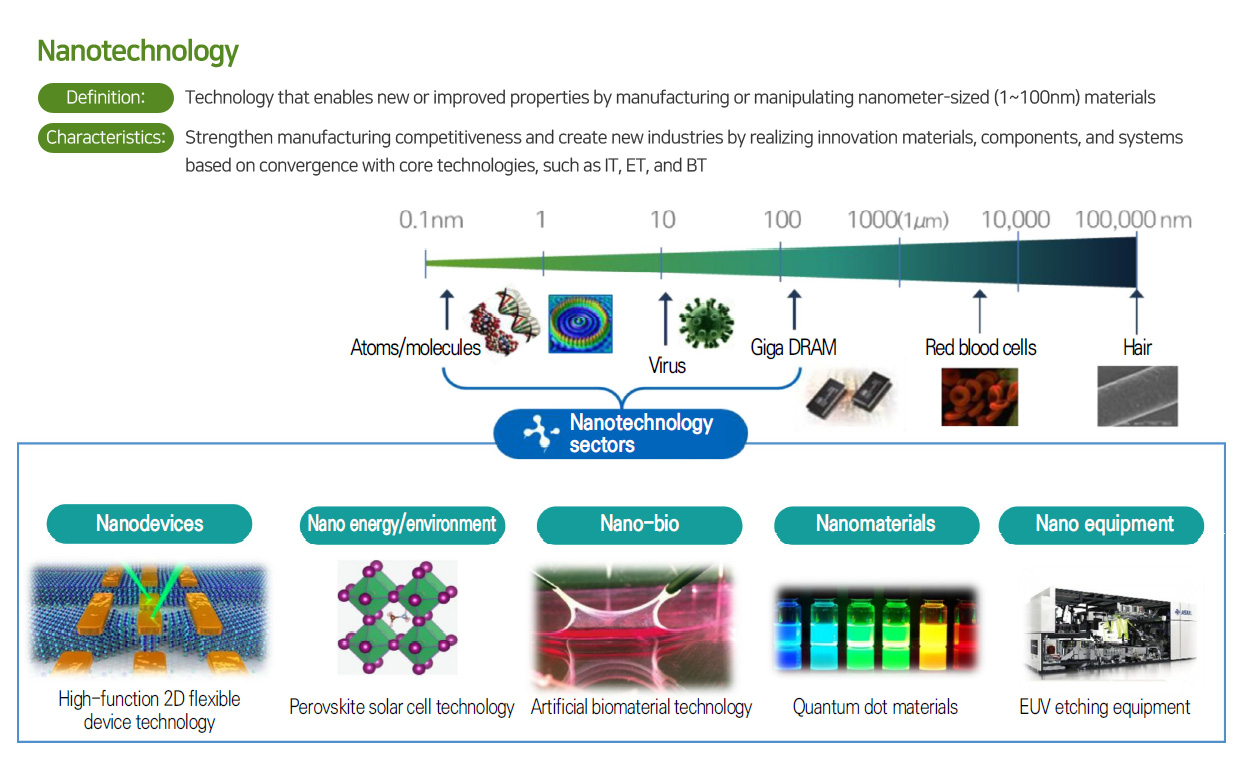
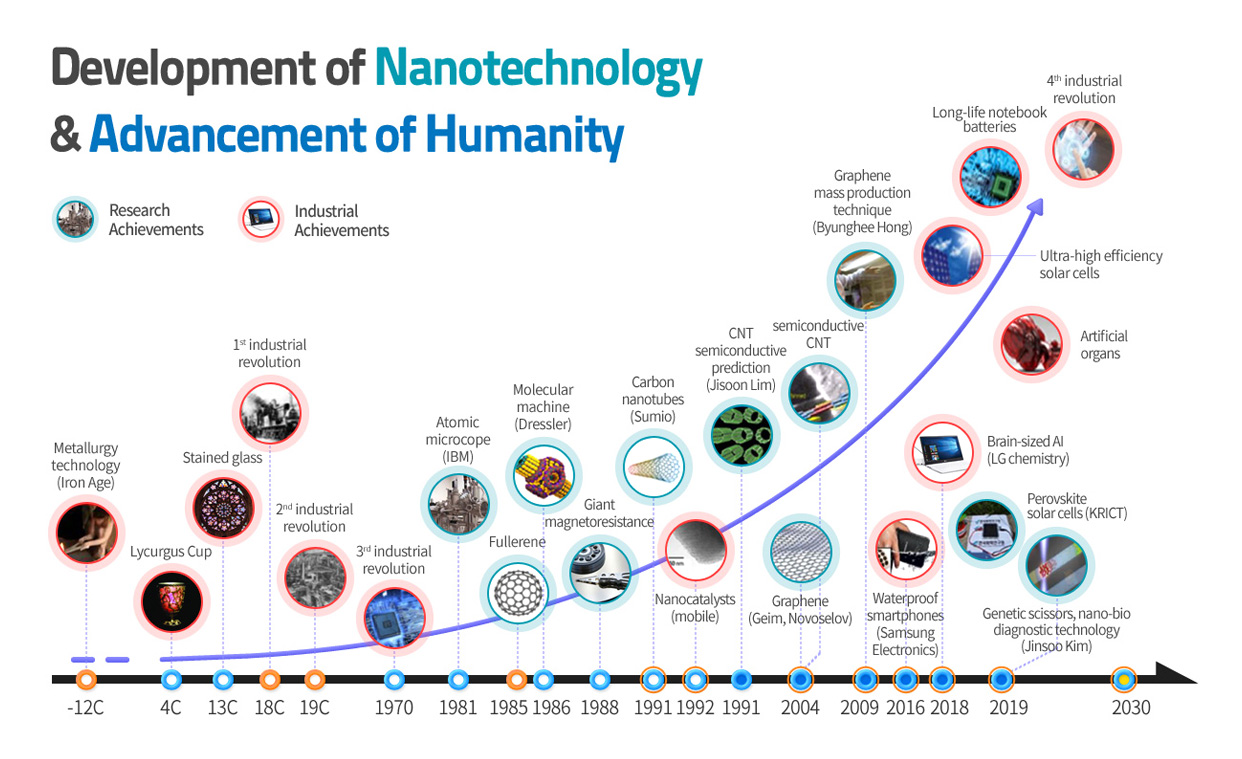
Note 2 Nanotechnology and future society



2. Formulation rationale and status
As stipulated in the Act on the Promotion of Nanotechnology,* the government shall formulate Korea Nanotechnology Initiative every five years to implement policies and projects of relevant departments and agencies
- In accordance with the Act on the Promotion of Nanotechnology (Dec. 26, 2002) and the Enforcement Decree of the same Act (Jun. 25, 2003), Korea Nanotechnology Initiative shall be revised and supplemented every five years.
Act on the Promotion of Nanotechnology
- Article 4 (Formulation of Korea Nanotechnology Initiative) (1) The Government shall formulate and implement a comprehensive nanotechnology initiative (hereinafter referred to as the “initiative”) to promote research and development of nanotechnology.
(5) Where necessary due to changes in the trends of development and conditions of research and development of nanotechnology, the government shall revise and supplement the comprehensive development initiative pursuant to Clause 3.
Nanotechnology Initiative is the greatest plan for nanotechnology in the science and technology sector in South Korea, and it is laterally linked to many basic plans
- Based on six major categories* of NTIS, nanotechnology is included in about 20 basic plans of the government.
* Material, biotechnology/medical, basic/infrastructure, public/space, ICT/convergence, energy/environment
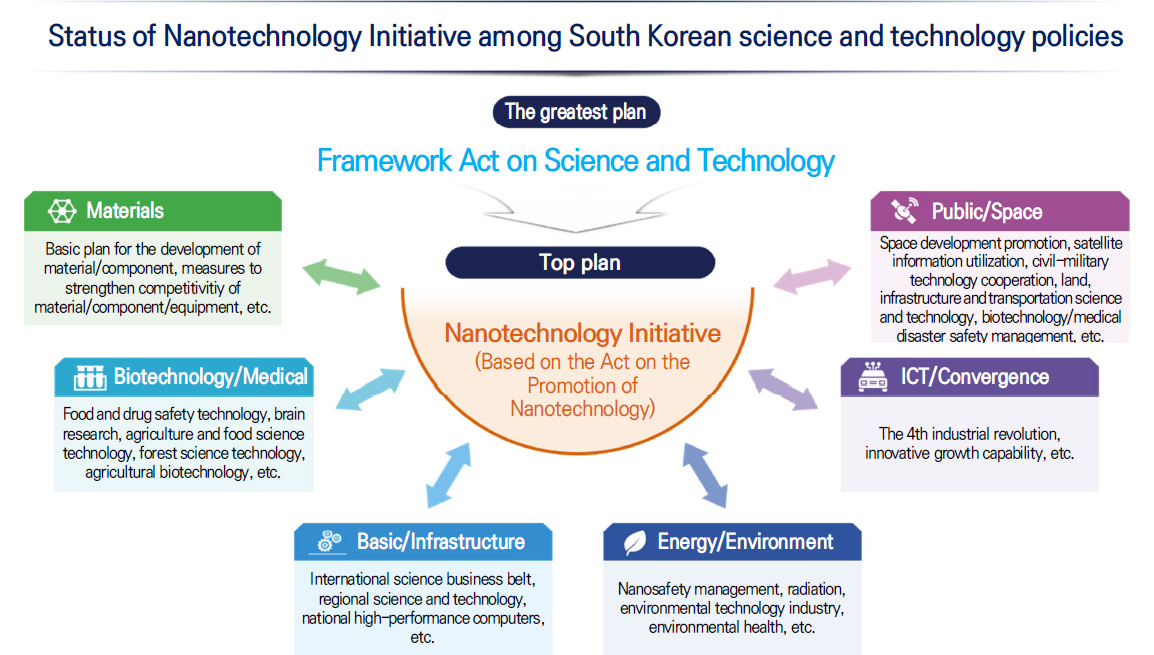
3. Formulation system and progress
(Plan formulation and implementation system) With the Ministry of Science and ICT (MSIT) in charge, an implementation committee with relevant ministries was organized, and a planning committee, consisting of various ministries, organizations, and nanotechnology experts, was formed to prepare the 5th Korea Nanotechnology Initiative (KNI)
※ (Relevant ministries) Ministry of Science and ICT, Ministry of Trade, Industry and Energy, Ministry of Economy and Finance, Ministry of Education, Ministry of Agriculture, Food and Rural Affairs, Ministry of Health and Welfare, Ministry of SMEs and Startups, Ministry of Environment, Ministry of Food and Drug Safety
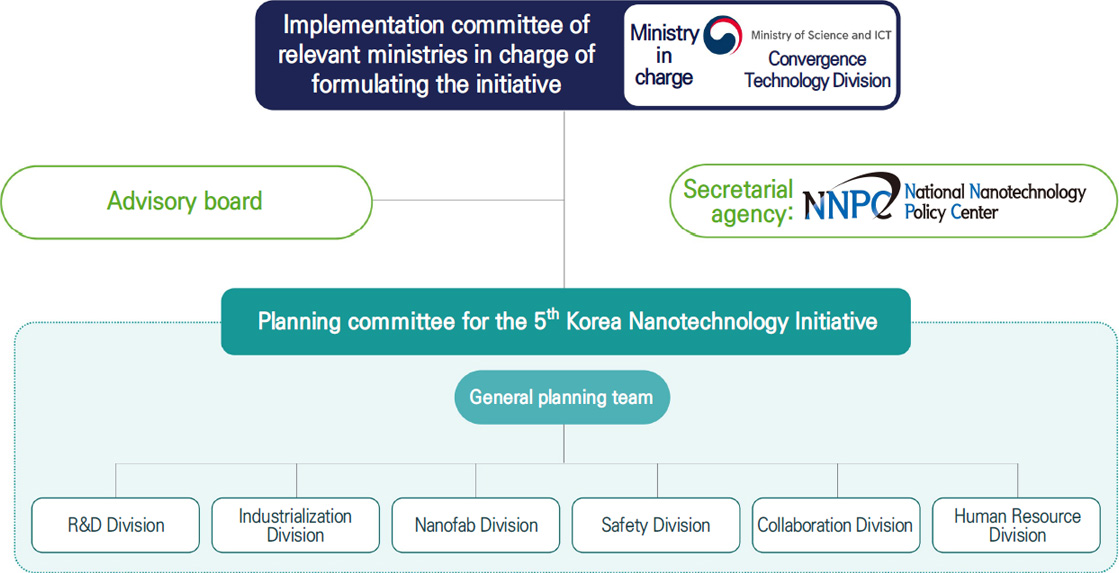
- Roles by planning committee division
| Division | Implementation details | |
|---|---|---|
| General planning team | Conduct general review of the plan, coordinate the system between strategies and tasks |
|
| R&D | R&D strategy | Formulate innovative and challenging global-leading nano research strategies and tasks |
| Future R&D | Presentation and discussion of major R&D issues in relevant fields with participation by young researchers |
|
| Industrialization | Reinforce competitiveness of the nano convergence industry led by innovative growth |
|
| Nanofab infrastructure | Specify operational upgrade and reorganization of nanofab infrastructure system |
|
| Human resources (HR) | Establish strategies for developing nanotechnology professionals |
|
| Cooperation | Establish global collaboration strategies for open innovation |
|
| Safety/standardization | Establish strategies for leading nano-safety and standardization |
|
| Promotional TF | Establish measures for enhancing national perception about nanotechnology |
|
Implementation progress
A total of 105 industry-academia-research (IAR) experts from nano-related fields participated in the general planning team and six specialty divisions to present strategies and tasks to be implementated by each division by holding over 50 meetings
| Implementation progress | Major details | ||
|---|---|---|---|
| Jan.–Mar. 2020 | Analysis of the achievements from the 4th KNI |
Analyzed achievements from the 4th KNI Analyzed foreign nanotechnology-related policy trends |
|
| Apr.–May 2020 | Vision TF activities in order to composite the 5th KNI |
Planned discussions for the vision/goals/tasks and implementation direction for divisions for the 5th KNI Assembled the 5th KNI planning committee |
|
| Jun. 22, 2020 | Kick-off of implementation committee consisting of related ministries |
Discussed implementation plan for formulation of the 5th KNI around ten ministries and key experts |
|
| Jul.–Nov. 2020 | Planning activities by the planning committee (general planning team and divisions) |
Assembled the general planning team and seven related divisions, constructed the plan Held approximately 50 meetings with the general planning team and each division (as of Nov. 31) |
|
| Aug. 28 | First general planning team meeting |
Reviewed composition of strategies/tasks |
|
| Oct. 12 | General planning workshop meeting |
Coordinated strategy system, reviewed sub-tasks |
|
| Nov. 2–4 | Agenda grouping |
Intensive revision and supplementation of sub-tasks by strategy |
|
| Nov. 4 | Second general planning team meeting |
Reviewed and discussed the results of agenda grouping |
|
| Nov. 2020 – Jan. 2021 | Online public hearings (two sessions) |
Announced 2021 Nano Convergence Conference (Nov. 26) National Nanotechnology Policy Center and gathered opinions from IAR (Dec. 2020–Jan. 2021) |
|
| Feb. 2021 | Opinion-gathering from ministries |
Opinion-gathering on the agenda from relevant ministries |
|
| Feb. 2021 | Specialized committee of the council |
Preliminary review by the Committee of ICT and Convergence |
|
| Mar. 2021 | Steering committee of the council |
Preliminary review by the steering committee of the council |
|
| Apr. 2021 | Meeting with civilian members of the council |
Preliminary meeting of civilian members of the council |
|
| Apr. 2021 | Introduction of the agenda from the President's Council of Advisors on Science and Technology (PCAST) |
Proposal of the 5th KNI was approved |
|
| May 2021 | Booklet publication and promotion |
Promotion targeting relevant ministries, organizations, and IAR personnel |
|